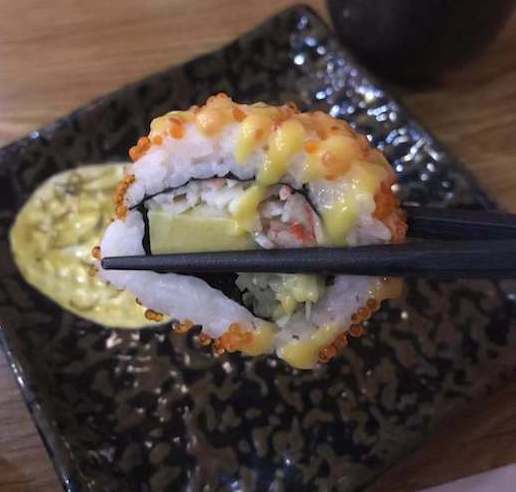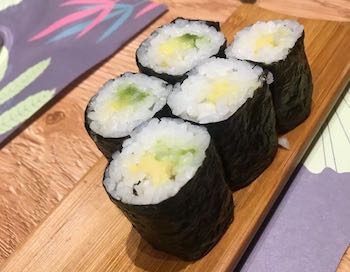We are reader supported. When you purchase through links on our site, we may earn an affiliate commission. Also, as an Amazon affiliate, we earn from qualifying purchases.

Avocado is a common and very loved ingredient in everyday sushi. But is avocado, the American fruit, part of traditional Japanese sushi?
Traditional sushi does not have avocado in its rolls. You may find that shocking because we are so used to eating avocado in our sushi rolls. But this is actually an American invention, and traditional Japanese cuisine does not have any relation with avocado.
Now you might be wondering how little you know about real sushi and from where did avocado sushi mixtures come from. Stick with our article, and you will find out all the needed details.
The combination of avocado and sushi
Since you now know that traditional sushi does not have avocado, the real question is why and from where it emerged in sushi combinations.
The popular story says that this avocado-sushi merge started 45 years ago. A Japanese Chef was trying to make traditional sushi, but he had difficulties with finding Toro – fatty area of tuna, that is a crucial part of sushi. The taste of Toro is often characterized as really smooth and gentle. Toro has its own further divisions, but we will not go in depth about it here.
The story goes on – finding Toro, that specific part of tuna, was a real problem during that time. And here is where avocado stepped in the game. The Japanese Chef found avocado, favorite fruit in many U.S. dishes, that turned out to be a perfect alternative to Toro.
So basically, avocado is just a substitute for Toro – fat area of the tuna, that traditionally goes in sushi. Moreover, what it’s funny is that the Japanese chef invented this collision, but it’s eaten in the U.S. type of sushi.
Due to the influence of American culture, it is not uncommon that type this of sushi – avocado sushi – is eaten in all of the western countries.
Avocado and any other ingredient that is non-seafood are really rear in real Japanese sushi. Traditional sushi is strongly connected with raw seafood and a few crucial components, and that is definitely not avocado.
Some say that avocado, favorite tropical fruit growing in Central America and Mexico, is the main problem of the false perception of sushi. Why?
Well, the emergence of avocado in sushi made the invention of California roll (we will talk about them a bit later) – and this led to the growing popularity of sushi. This popularity has spread pretty fast, but this sushi fame conveyed the terribly wrong picture of what the traditional sushi is.
This picture of Japanese sushi set the tone for almost the entire world – because now, sushi became the over commercialized meal that is prepared for masses and with entirely wrong ingredients, that are fat and filling (yes, we are speaking about avocado).
The volume and mass took the win over quality and raw sushi. So, to put it in a nutshell – no, the original Japanese sushi does not contain any form of avocado.
Types of sushi rolls with avocado
Avocado is a common fruit that is used in many dishes and its one of the most typical to be seen in (western) sushi. Avocado doesn’t contain any cholesterol free; it’s super healthy and most important – it blends perfectly in the sushi roll.
When the avocado started to replace for Toro, many different kinds of sushi rolls began to use the fruit and from there – new types of sushi rolls were created. We will go through the popular and most familiar ones:
• Avocado Roll
You can guess this one right away. It is a pretty plain roll – it consists of avocado and rice. Simple yet many people are real fans of this sushi roll.

• The California Roll
As we mentioned, this type of sushi roll made sushi famous all over the world. It contains avocado, crab and cucumbers. You can find out the recipe in this article.
• The Caterpillar Roll
This is also one of the most well-known sushi rolls in the U.S. It includes eel, cucumber, and avocado. Clearly an interesting one. Read on to see more info about caterpillar poll and recipe.
• The Philadelphia Roll
This sushi roll includes salmon, avocado, and cream cheese. This kind of meal would never be served in a traditional Japanese sushi restaurant! You can find the recipe in this article.
Difference between traditional sushi and sushi around the world?
This is the question many people ask and don’t even realize its importance. Is there any difference between preparing and serving sushi in a traditional form compared to the sushi in the western world? Some people long for a real sushi experience, while others are just interested in knowing if they are eating real Japanese food.
Sushi is now a famous food around the world, but many don’t understand what the dish actually is. Sushi is often mistaken for sashimi – that is sliced raw fish ( Click to see the difference). But raw fish (sashimi) is the essential ingredient in sushi.
It may sound surprising to many people that sushi indeed contains rice seasoned with vinegar and not the mixture we used seeing, especially in the U.S. – just rolled rice with seaweed.
Authentic sushi is made with white rice, rice vinegar and raw seafood such as salmon, tuna or shrimp. Many kinds of sushi are vegetarian and are served with cucumber rolls. And regarding the seasoning and dipping – there are always soy sauce and wasabi (Japanese horseradish).
One more difference between “eastern” and “western” sushi is the wrapping of the sushi. In Japan, the rolls are wrapped with nori (seaweed) on the outside of the role. And in western countries, the rice is jammed around the nori which is wrapped around the fish.
Moreover, in authentic Japanese sushi, it’s all about fresh, raw fish and the ingredients in sushi will depend on the daily catch. It’s like the fresh fish is the norm for real sushi and it’s perfectly clear why they don’t want any additional or mixed flavors – it’s the freshness and simplicity that matters.
This is most likely connected to the history of sushi – the vinegar preserved the freshness of the fish.
When thinking like that, it turns out that American or western sushi is almost a different kind of food than traditional sushi. In the U.S. or most of the western countries, we are accommodated to strong flavors and different colors and is something that has little ties with traditional sushi.
Traditional sushi is thriving for balance and delicate flavors, freshness and the ability to experience the real flavors. We could say that western sushi is inspired by traditional Japanese sushi. In the end, there is a massive difference in what you would taste in Japan and America if you headed in sushi restaurants.
Related Questions
1. How to use avocado in sushi?
If you just love the taste of avocado in your sushi, even though now you know that this is not the traditional sushi, here is how you can use it at home.
Step 1: Cut the avocado in half
Step 2: Peel the skin and remove its seed
Step 3: If you are using avocado for sushi filling just cut the avocado into 1 cm thin slices
Step 4: If you want to use avocado for sushi topping you need to take a few more steps. Peel the slices of avocado with a peeler, then place the peels on top of an inside out sushi roll. Now – press the peels strongly to the roll (you can use a bamboo mat).
2. Are there any other fruits used in sushi?
Yes, you wouldn’t believe what all sorts of sushi fruits are out there. If you are ready to experiment there are much different fresh fruit sushi waiting for you.
Moreover, some of the combinations originated from Japan and are served that way for a long time. On the other hand, many blends are for sure not traditional, but people love it.
We can start with avocado, that started the „fruit sushi “event. It’s a very healthy fruit and it’s the one sushi combination people most commonly eat.
Let’s move to the weird part. Banana sushi? Yes, that exists. It may seem odd, but people love this combination and call it dessert sushi. Now you see what a long road had sushi taken from a raw fish roll to banana sushi dessert.
It may not seem like a bright idea, but if you are a vegan trying out some new stuff give it a go.
Next, pickled plums without seeds sometimes make a nice addition to sushi. Moreover, in Japan, they call it umeboshi; they are salted and very popular.
And lastly, you can add whatever you want because many other fruits work great in sushi. At first, you might just be thinking of sushi in a salty way – but there is a thing called dessert sushi, and you should try it.
Different type of fruits like apples, oranges, watermelon, or grapes can be great in sushi. A lot of these fruits are perfect for making your fruit dessert sushi. Some are surprisingly a great combination with rice, other fruits, and vegetables, or even raw fish!
Related article: 30 Good Ideas for Sushi Roll Fillings

